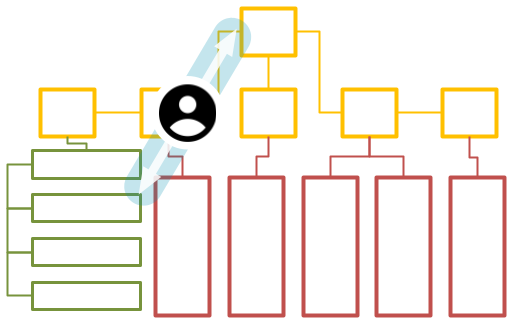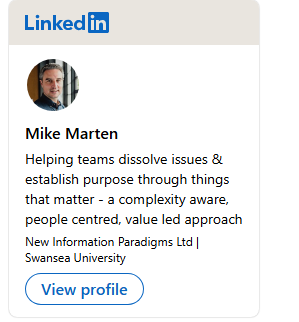Transformational Leader Profile
A Transformational Leader is one of three roles we’ve identified as being critical in change initiatives.

A Transformational Leader is a seasoned, influential senior leader, potentially a CEO, rewarded with their role for successful change initiatives. They are responsible for organisational goals, have authority over resources, and shape the company culture. Though they depend on others for new ideas, they are adept at driving change, challenging norms, and overcoming obstacles. Their challenges include grasping complex issues, managing information overload, and attracting top talent. Despite fears of making wrong decisions and facing negative publicity, they are driven by desires for organisational growth, workforce productivity, and personal career advancement.
A Transformational Leader:
has clear authority in their organisational role
Senior Position and Reward for Past Success: They are likely senior, often having reached their position as a reward for successful past change initiatives. They could be a CEO, or head of a specific function, whether vertical (business units) or horizontal (technology, best practice, etc).
Responsibility for Organisational Goals: They are significantly responsible and accountable for meeting organisational goals and targets.
Authority to Act and Resource Discretion: They have the authority to act and significant discretion to use resources.
Culture Influencer: They have the power to influence culture within the organisation.
Protectors of Change Initiatives: They protect change initiatives and those involved in them.
has strategic focus and is innovative
Change Intuition: They intuitively sense when drift has happened and when change is needed (or at least rapidly recognise it if it is pointed out by others) and discern when to throw weight behind an initiative.
Risk Awareness: They know that risks are involved, and that the organisation’s culture or ethos may be disrupted, but that, overall, change is more than worth it.
Reconnection to Vision and Purpose: They want to “reconnect” focus, strategy, and operations to the original vision and purpose of the organisation, as anchored in customer value, which they deeply care about and actively seek to drive.
has change management experience and resilience
Overcoming Barriers: They overcome barriers and obstacles by adapting, creatively interpreting, or working around processes.
Norm Challenging: They challenge norms and accepted wisdom as far as possible within their environment.
Circumventing Structures: They will circumvent existing structures (where necessary), whether endorsing internal “skunkworks”, or to bring in expertise and impetus from outside – consultants, alliances, etc.
is people and team oriented
Reliance on Others for Opportunity Sourcing: They are often very busy within their role, and somewhat removed from the front line (even if they previously worked on the front line) which means that they rely on others to “source” the opportunities and ideas that they can then drive.
Recruitment and Involvement Skills: They exhibit passion, drive, and responsibility, and strong interpersonal, networking, and collaborative skills – which help recruit, involve and carry along others.
Recognition and Responsiveness: They recognise and respond to, and often actively look out for, individuals who are discerning, creative, and motivated to realise change – especially when such individuals make a strong case for that change.
Change Advocacy and Sponsorship: They look out for, advocate for, and sponsor promising change initiatives, and take responsibility for effectively communicating about that change.
Role in the conventional organisation:

A Transformational Leader:
- is likely senior, often having reached their position as a reward for successful past change initiatives.
- may be a CEO, or head of a specific function, whether vertical (business units) or horizontal (technology, best practice, etc).
- is significantly responsible and accountable for meeting organisational goals and targets.
- has the authority to act and significant discretion to use resources
- influences cultures
- is often very busy within their role, and somewhat removed from the front line (even if they previously worked on the front line) which means that they rely on others to “source” the opportunities and ideas that they can then drive.
Perspectives on, and challenges arising from Change
Questions they may ask themselves in Change situations
Where to Focus Attention: In a complex and rapidly changing environment, deciding where to focus attention can be challenging. How can a leader identify the most critical issues that need attention?
How to Make the Right Decision: With so many factors to consider, making the right strategic decisions can be difficult. How can a leader ensure they are considering all relevant factors and making the best possible decision?
Whom to Trust: Trust is a fundamental aspect of leadership. How can a leader determine which team members and external partners are trustworthy and reliable?
How to Maintain an Engaged Workforce: Keeping employees motivated and engaged is critical for organisational success. What strategies and practices can a leader employ to maintain high levels of engagement?
How to Utilise AI: With the rise of artificial intelligence, understanding how to best leverage this technology for the benefit of the organisation is essential. How can a leader implement AI in a way that enhances organisational capabilities without causing undue disruption?
How to Handle Resistance to Change: Resistance can be a major roadblock to change initiatives. How can a leader best manage and overcome resistance to change within the organisation?
How to Balance Short-Term and Long-Term Goals: Striking a balance between addressing immediate concerns and working towards long-term strategic goals is challenging. How can a leader effectively navigate this tension?
How to Foster Innovation: In a competitive business environment, fostering innovation is crucial. How can a leader create a culture that encourages creativity and innovative thinking?
How to Measure Success: Determining the right metrics to evaluate success can be tricky. How can a leader ensure they are accurately measuring progress and success?
Reasonable Expectations in Change situations
Truth and Integrity: Leaders expect honesty from team members, accurate information, and people doing what they say they will. Integrity forms the basis of a trustworthy and productive working environment.
Steady State with Room for Exploration: While maintaining regular operations, leaders expect to identify and exploit new opportunities. They expect stability but also adaptability within the organisation.
Empowered Decision-Making: Leaders expect team members to feel empowered to make decisions within their purview, reducing the need for unnecessary escalations.
Accountability: Leaders expect team members to take responsibility for their actions and decisions, promoting a culture of accountability.
Collaboration: Leaders expect team members to work collaboratively, fostering an environment that promotes teamwork and shared success.
Continuous Improvement: Leaders expect everyone in the organization to continually strive for improvement, fostering a culture of learning and development.
Innovation: Leaders expect team members to think creatively and innovatively, contributing fresh ideas to drive the organization forward.
Alignment with Vision and Goals: Leaders expect all actions and decisions to align with the organization’s vision and strategic objectives.
Roadblocks to progress in Change situations
Detachment from Frontline Action: Being in a senior leadership position may mean being removed from day-to-day operations, making it harder to fully understand and address real-time issues.
Inefficient Processes and Structures: Bureaucracy, overly complicated processes, or hierarchical structures can impede quick decision-making and agile action.
Middle Management and ‘Yes Men’: Employees who simply agree with everything to avoid conflict can stifle innovation and obstruct necessary change.
Legacy Vendors, Systems, and Approaches: Existing relationships with vendors, ingrained systems, and traditional approaches to doing business can be difficult to change and may not be suitable for the current environment.
Blindness to Problems: Team members may be overwhelmed, unable or unwilling to see or declare problems, which can prevent issues from being addressed promptly and effectively.
Endless Problem-Solving: Continuously dealing with problems, whether direct or indirect, can divert attention and resources away from strategic initiatives.
Resistance to Change: Employees resistant to change can make it difficult to implement new strategies or systems.
Lack of Resources: Limited resources, whether financial, human, or material, can hinder the implementation of strategic initiatives.
Rapid Technological Changes: Keeping up with rapid advancements in technology can be challenging and can disrupt established ways of doing business.
Regulatory Constraints: Compliance with evolving regulations and standards can impose additional challenges on transformation efforts.
Types of Problem that may be encountered in Change situations
Lack of Insight: Failing to grasp the full depth of an issue due to various factors such as lack of time, insufficient information, or complex dynamics.
Overwhelming Information and Noise: In an era of rapid change and digital overload, sorting through vast amounts of information and distinguishing valuable insights from irrelevant data can be a daunting task.
Execution Issues: Even the best-laid plans can falter during execution. Challenges could arise from ineffective processes, poor team dynamics, or inadequate resources.
Prioritisation Struggles: With numerous responsibilities and demands on their time, transformational leaders may find it challenging to focus on the most impactful tasks or strategic initiatives.
Attracting and Retaining Top Talent: Identifying, recruiting, and retaining high-performing individuals can be a significant challenge, especially in a competitive job market.
Developing Future Leaders: Ensuring the cultivation of the next generation of leaders within the organisation, including identifying potential leaders and providing appropriate development opportunities.
DEI/Sustainability/HR Initiatives: Meeting the rising expectations for Diversity, Equity, and Inclusion (DEI), sustainability, and other socially responsible practices can be a complex task. Balancing these initiatives with other strategic objectives can also pose a challenge.
Coping with Change or Adversity: Transformational leaders may feel cornered with no viable option in times of crisis or significant change, which may lead to resignation, denial, doubling-down on existing strategies, or resorting to short-cuts.
Resistance to Change: Even with the best intentions and strategies, transformational leaders can face resistance to change from employees who are comfortable with the status quo.
Maintaining Organisational Culture: While driving change, leaders must ensure the core values and culture of the organisation are not compromised.
Balancing Short-Term and Long-Term Goals: Navigating the tension between addressing immediate concerns and focusing on long-term strategic goals can be difficult.
Common Fears emerging in Change situations
Making the Wrong Call: The fear of making a critical mistake that could have significant negative repercussions for the organisation.
Missing Impactful Opportunities: The anxiety of missing crucial opportunities for impact and falling behind peers in similar roles, thereby compromising the competitive position of the organisation.
Accountability for Failure: The fear of bearing the blame if things deteriorate beyond repair or if a high-profile initiative fails.
Exposure of Ignorance or Incompetence: The fear of being “found out” for not fully understanding key issues or failing to maintain an awareness of critical trends and developments.
Negative Publicity: The fear of negative media attention that could harm the organisation’s reputation.
Reporting Losses: The fear of having to report significant losses or failures to the board or shareholders, particularly in situations where there is no obvious path to recovery.
Losing Key Talent: The fear of losing high-performing employees who are critical to the organisation’s success.
Struggling with Talent Acquisition: The fear of not being able to attract and hire the necessary talent to achieve strategic objectives.
Forced Redundancies or Change: The fear of having to make difficult decisions about layoffs or other major changes, particularly if these are imposed by external forces or resistance within the organisation.
Burnout: The fear of becoming overworked and burned out due to the high demands of the role and the pace of change.
Losing Sight of Personal Values: The fear of having to compromise personal values or the core values of the organisation in the pursuit of business objectives.
Organisational Stagnation: The fear that the organisation will become complacent and fail to innovate or adapt, leading to stagnation or decline.
Motivating Desires in Change situations
Happy and Productive Workforce: Leaders desire a positive work environment where employees are happy, motivated, and highly productive.
Insight without Conflict: Leaders seek to gain deep insight into business matters without causing unnecessary disturbance or controversy within the team.
Clear Differentiation from Competitors: Leaders desire their organizations to be distinctively recognized in terms of the value delivered to customers and shareholders.
Recognition for Success: Leaders seek acknowledgment for making the right strategic choices and for their contributions to the success of the organization.
Career Advancement: Leaders aspire to expand their options, seeking the time and the opportunity to focus on personal development to secure their next career progression.
Work-Life Balance: Leaders desire the confidence and peace of mind to relax and enjoy their free time without being constantly worried about work.
Strategic Impact: Leaders desire to make strategic decisions that have a significant positive impact on the organization’s performance and success.
Organizational Growth: Leaders wish to see their organization grow and prosper, continually reaching new heights in terms of performance and market presence.
Cultural Influence: Leaders desire to shape a strong, positive organizational culture that aligns with their values and fosters employee engagement and productivity.
Personal Growth and Learning: Leaders wish to continue learning and growing, both personally and professionally, through their experiences and challenges.

